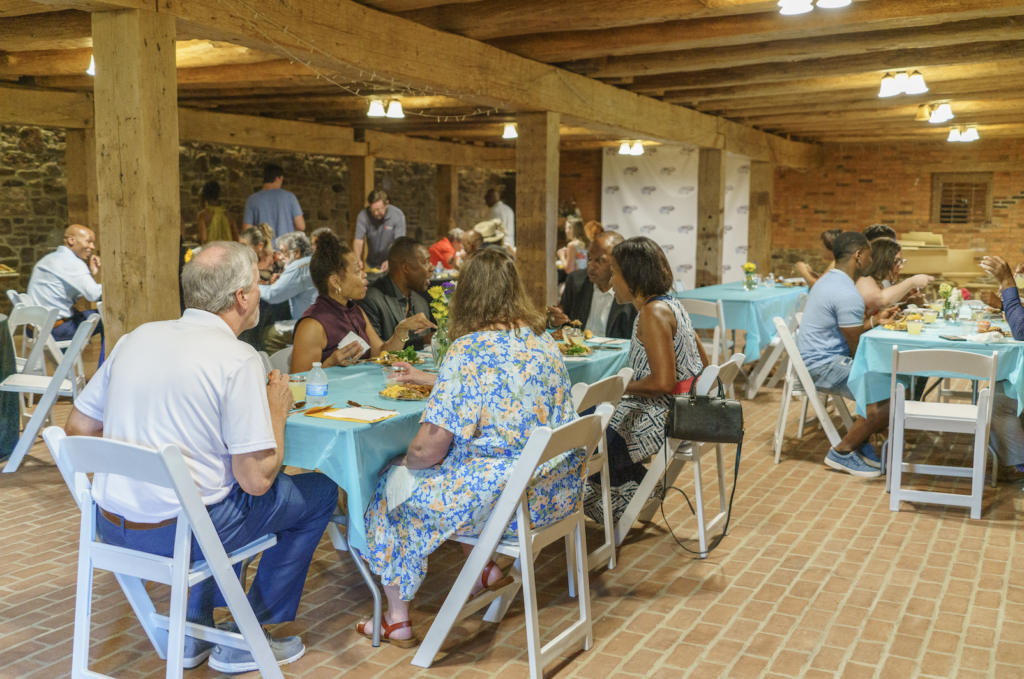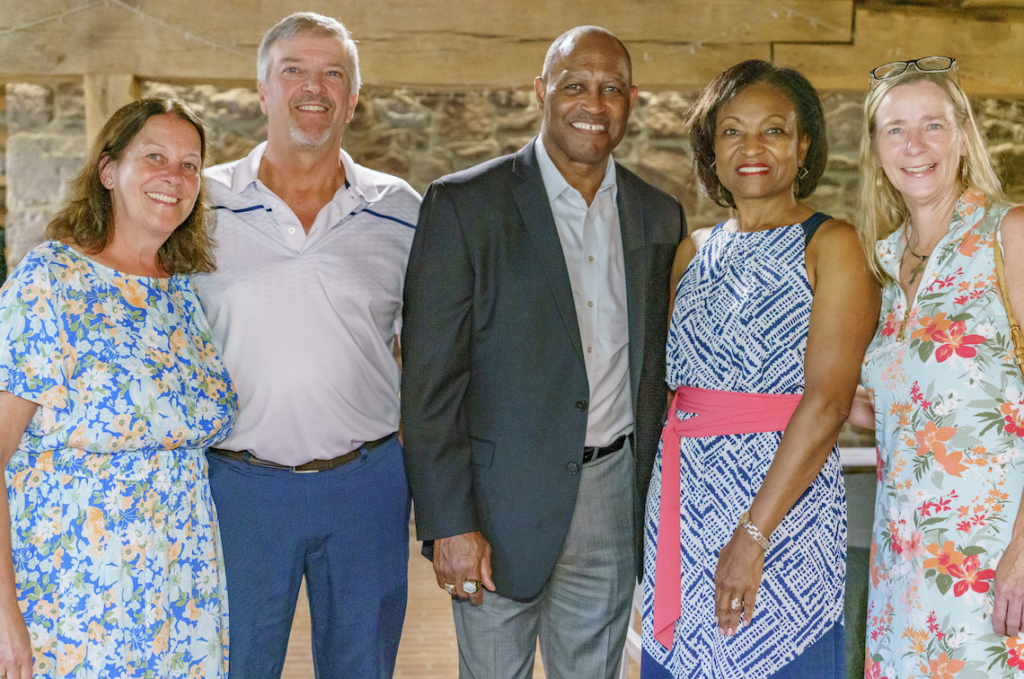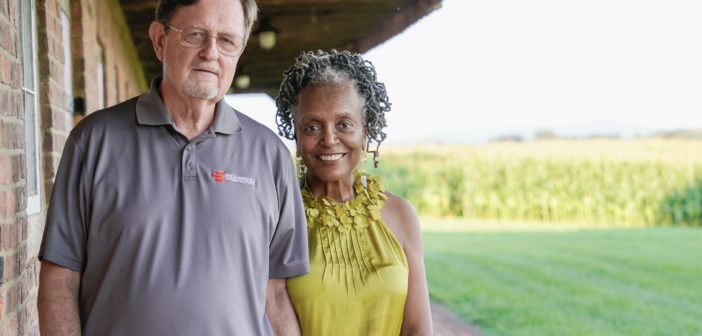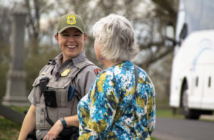Patricia Green Rodgers launches a one-woman campaign to welcome Black visitors to Adams County
By Karen Hendricks | Photography by Melissa Ring
She flew from Los Angeles to spend a weekend in Gettysburg.
NaNotchka Chumley, D.O., a busy family medicine physician, made those cross-country plans after receiving an invitation from a longtime contact, Patricia Green Rodgers of Littlestown. Rodgers was organizing an event-filled weekend, primarily focused on introducing attendees to Gettysburg’s Black history.
“I didn’t know that much about Gettysburg beyond the Gettysburg Address,” says Dr. Chumley. “It sounded like an exciting, informative weekend—it caught my interest.”
Knowing Rodgers, and her planning skills, also compelled her to travel those 2,600 miles.
“Patricia can motivate the masses,” says Dr. Chumley.
And so, on the last weekend in August, 18 visitors traveled to Gettysburg to learn more about the town—its place in American history, as well as its significance in Black American history—all sparked by one woman’s itinerary and initiative.

Her Story
Rodgers, 73, moved to Adams County six years ago from Maryland. Her husband Bob had retired, and the couple relocated to his historic family property, Stone of Scone Farm in Littlestown.
She began absorbing Gettysburg’s history, appreciating stories that tied into her own Black heritage. Stories local historian Jean Green shared about Gettysburg’s predominately Black Lincoln Cemetery. Stories about the Underground Railroad (UGRR) told by Curt Musselman of Historic Gettysburg Adams County (HGAC). And those stories resonated deep within her.
“I was born in a segregated Richmond, Virginia, and I attended segregated schools, first grade through 12th. I had all Black teachers except for one,” recalls Rodgers.
History lessons, taught by those Black teachers, didn’t always correspond to the history books.
“There were many things in the history books that were wrong. They said the slaves were happy. They said the Virginia Indians were savages—that they killed white women and children,” says Rodgers. “Anything they said historically about us, our teachers would say, ‘That’s not who we are—that’s not the truth about who we are, never, deny it.’ And that stayed in me.”
Having earned two masters’ degrees—in social work and public relations—Rodgers says her life’s work has focused on one central theme, building bridges of communications and connections.
And Rodgers’ life journey spans quite a bridge, from the former capital of the Confederacy—Richmond—to her current hometown a few miles from Gettysburg, known as the turning point of the Civil War. It was the Battle of Gettysburg that ultimately led to the Confederacy’s downfall and Union victory.
At this point and place in her life, she wants to pay homage to those childhood teachers by sharing Gettysburg’s history—encompassing Black history—with her friends and colleagues, a social circle that spans the globe.
But Rodgers envisions more than history. If she could design weekend getaways that increase foot traffic—financially—into Gettysburg’s shops, restaurants and accommodations, those tourism dollars, she believes, would generate more than cash register receipts. They would raise awareness, within Gettysburg’s tourism community, of a virtually untapped segment of tourism and its potential value: Black travelers.
Gettysburg Connections
Her first two curated weekends, in summer 2022, were girlfriend getaways. Each time, 20 women gathered, toured, shopped and stayed in Adams County.
“Power couples”—including Dr. Chumley and her husband—received Rodgers’ third round of invitations for August 2023. And Rodgers brought in a headline power couple: Joy Maxberry Woodruff and Judge Dwayne Woodruff, a retired Pittsburgh Steeler who is the first NFL player to attend law school, graduate and begin practicing law—all while being an active player. The couple spoke during a Saturday evening dinner program at the Adams County Historical Society’s Beyond the Battle Museum.
Also in attendance was “power couple” Flo McAfee—who worked in the Clinton White House—and her husband George Stewart, of Alexandria, Virginia.



“It was an uplifting and inspiring weekend,” says McAfee. “It helped me broaden my perspective of Gettysburg [and the Civil War]. It wasn’t just wars and battles that were fought—it’s the why.”
During Musselman’s Underground Railroad Tour, the “why” struck a chord with her.
“There was the battle and that sense of freedom, but there was another side of freedom,” McAfee says, referring to runaway slaves—or more correctly, freedom seekers. “To be guided by the stars, the river, to understand the resilience of people when they want freedom—it helped me understand that freedom was happening on several different levels.”
The Underground Railroad, Musselman explained, relied on an Adams County network. Abolitionists and station masters included the McAllisters—just north of the Mason-Dixon Line—along with Black communities in Gettysburg and Yellow Hill, stretching north to Upper Adams’ Quaker communities.
“The resistance to slavery and to racism, then as now, takes a village,” says Musselman. “Gettysburg likes to think of itself as a welcoming community. And the idea that it can go from being a killing field to a healing ground should be compelling for everyone. Unfortunately, much of the reconciliation that has taken place here has been for whites only.”
Musselman believes Rodgers’ voice is being heard within Gettysburg’s tourism and historical circles.
“I think Patricia’s efforts are admirable and making a difference,” Musselman says. “Over the last decade, the stories being told at Gettysburg about the UGRR and the Black community have become more complete and nuanced.”
Future Focus
“We’re very fortunate to have someone like Patricia, with her authenticity, promoting our destination,” says Karl Pietrzak, president and CEO of Destination Gettysburg.
Rodgers invited him to speak to the couples in August, and he was thrilled to announce Gettysburg had just been named “the most welcoming city in the United States” by Booking.com. He presented gifts to the attendees—gifts crafted from “witness trees” standing during the 1863 battle.
Pietrzak says the tourism organization, along with the Gettysburg Foundation and National Park Service, strives to attract new visitors, including Black travelers.
“Efforts are underway related to the Black experience at Gettysburg and how we better communicate that to visitors,” says Pietrzak, referencing a new project in the works, under wraps for now.
It’s one of the bridges Rodgers set out to build.
“I want to give value and credit to what happened here, historically, and say there’s a [Black] story here that we don’t know,” Rodgers says, “so that maybe the tourism folks can create more that appeals to or resonates with us.”
As for Dr. Chumley, she flew back to Los Angeles filled with inspiration. She marvels at how Jean Green and the Lincoln Cemetery Project Association cleaned and restored the final resting place for many African-American veterans.
“We have a Lincoln Cemetery here in Los Angeles where my father is buried,” she says. “This is motivating me to find out if we have a cemetery society to keep the grounds up for our departed loved ones. You make time for things that are important, and Jean inspired me. I want my Lincoln Cemetery to look as nice as the one in Gettysburg.”
For more information:
Historic Gettysburg Adams County offers Underground Railroad tours at McAllister’s Mill every Saturday, May through August. Tours are coordinated by Curt Musselman, including special group tours such as the one he provided to Rodgers’ visitors. For more information, contact Musselman at
717-659-8827.
Destination Gettysburg, in partnership with the Adams County Historical Society, includes Black history stories on its website at destinationgettysburg.com/stories-gettysburgs-black-citizens.
The Lincoln Cemetery is located at 408 Long Lane, Gettysburg, and online at lincolncemetery.wixsite.com/lincolncemetery.
About the Sites
Stories about Adams County’s Black roots are emerging, thanks to grassroots efforts like Patricia Green Rodgers’ and many others throughout the community.
McAllister’s Mill, near Gettysburg National Military Park on Baltimore Pike, was likely the first Underground Railroad stop north of the Mason-Dixon Line for freedom seekers entering Adams County. The mill’s foundation and waterway remain. Historic Gettysburg Adams County has permission to lead tours of this privately owned property.
Lincoln Cemetery, established in 1867 by the Sons of Good Will, is the final resting place for more than 450 Gettysburg residents, including U.S. Colored Troops veterans of the Civil War. About half of the graves are marked. The Lincoln Cemetery Project Association formed in 1999 to protect this historic site as well as its stories. Restoration efforts continue.




